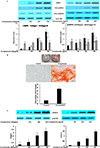Complement Upregulates Runx-2 to Induce Profibrogenic Change in Aortic Valve Interstitial Cells
- PMID: 33545156
- PMCID: PMC8326297
- DOI: 10.1016/j.athoracsur.2020.12.058
Complement Upregulates Runx-2 to Induce Profibrogenic Change in Aortic Valve Interstitial Cells
Abstract
Background: Calcium accumulation and fibrotic activities are principal mechanisms for calcific aortic valve disease (CAVD). Active complement products are observed in human stenotic aortic valves. Runt-related transcription factor 2 (Runx-2) is involved in tissue calcification. We hypothesized that complement upregulates Runx-2 to induce profibrogenic change in human aortic valve interstitial cells (AVICs).
Methods: AVICs were isolated from 6 normal and 6 CAVD donor valves. Cells were treated with complement cocktails. Profibrogenic activities and associated signaling molecules were analyzed by Western blot assay and collagen staining.
Results: Complement time and dose dependently enhanced profibrogenic activities in AVICs, and complement exposure also induced total collagen deposition in AVICs. Complement-induced profibrogenic responses were associated with increased Runx-2 expression and phosphorylation of extracellular signal-regulated kinase 1 and 2 (ERK1/2). Genetic silencing of Runx-2 decreased both matrix metalloproteinase 9 (MMP-9) and collagen I levels. Pharmacological inhibition of ERK1/2 decreased complement-mediated MMP-9, collagen I, and Runx-2 expression as well as total collagen deposition in human AVICs. Further, treating AVICs with heat-deactivated complement resulted in reduced MMP-9, collagen I, and Runx-2 levels compared with active complement treatment.
Conclusions: Complement induced profibrogenic activities in AVICs by activation of ERK1/2-mediated Runx-2 signaling pathways. This study demonstrates a potential role for complement-mediated CAVD pathogenesis, establishing a possible therapeutic target to limit CAVD progression.
Copyright © 2021 The Society of Thoracic Surgeons. Published by Elsevier Inc. All rights reserved.
Figures





Comment in
-
Complimenting Complement.Ann Thorac Surg. 2021 Dec;112(6):1972-1973. doi: 10.1016/j.athoracsur.2020.12.076. Epub 2021 Feb 16. Ann Thorac Surg. 2021. PMID: 33607049 No abstract available.
References
-
- Babu AN, Meng X, Zou N, et al. Lipopolysaccharide stimulation of human aortic valve interstitial cells activates inflammation and osteogenesis. Ann Thorac Surg. 2008;86(1):71–6 - PubMed
-
- Martin-Ventura JL, Martinez-Lopez D, Roldan-Montero R, Gomez-Guerrero C, Blanco-Colio LM. Role of complement system in pathological remodeling of the vascular wall. Mol Immunol. 2019;114:207–215. - PubMed
-
- Helske S, Oksjoki R, Lindstedt KA, et al. Complement systemis activated in stenotic aortic valves. Atherosclerosis.2008;196(1):190–200 - PubMed
MeSH terms
Substances
Supplementary concepts
Grants and funding
LinkOut - more resources
Full Text Sources
Other Literature Sources
Miscellaneous

